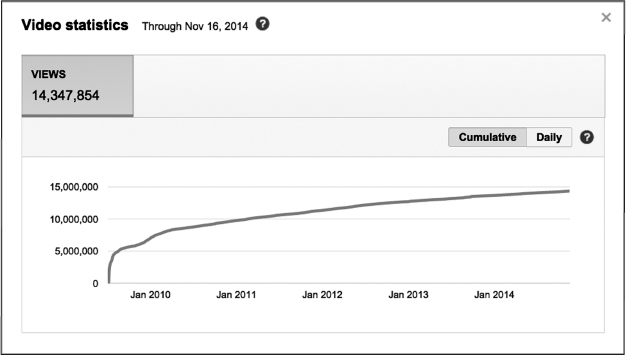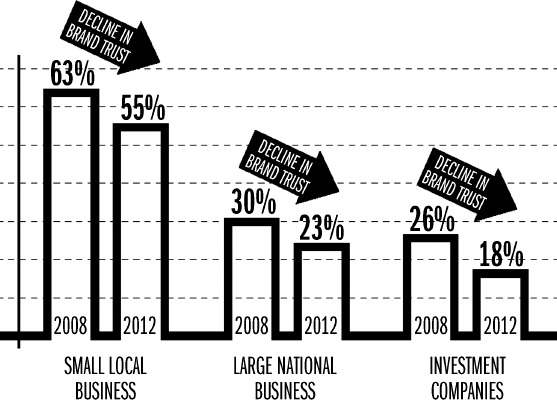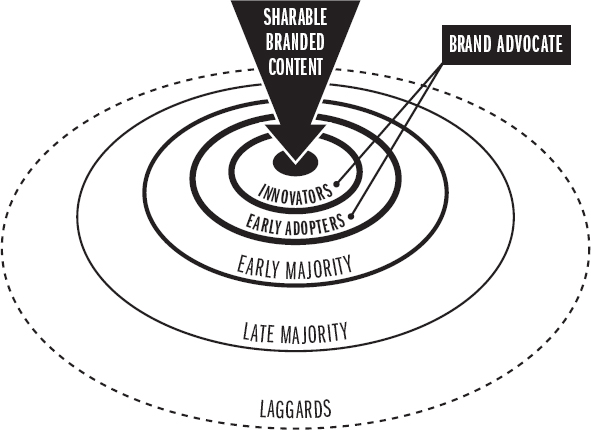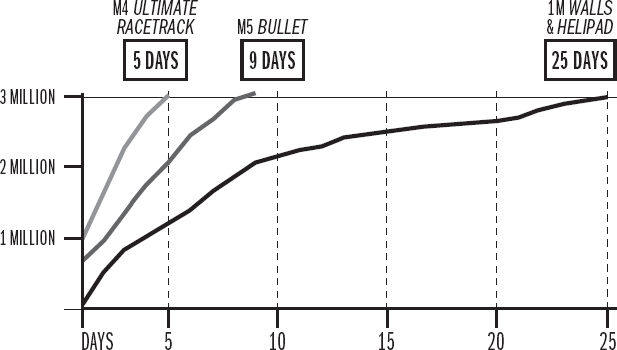CHAPTER THREE
CUSTOMER RELATIONSHIPS HAVE CHANGED
![]()
The Decline of Brand Trust and Rise of the Brand Advocate
WHILE WE EXPECT SO MUCH FROM THE CUSTOMER, THE customer is expecting even more back from the brand. And with history as our witness, customers (for the most part) are having trouble trusting brands, which means trouble for many businesses. Without a relationship based on trust, we are not likely to breed brand Advocates or even loyal customers who support us. Let's put the issue of brand trust in context.
We have all heard of David versus Goliath, and their mythical battle re-created for today when one individual armed with the power of social media takes on a corporate giant and wins. Well, it's no myth; it's now a business reality that happens daily in one form or another.
One example that has come to be known as the United Breaks Guitars video specifically comes to mind. This simple but effective message really set the benchmark for others to follow. The last time I viewed it on YouTube, the viewer count was at 14,347,854 (and I watched it twice more)—that's a lot of people who watched the video and shared the experience. To recap the story quickly, a battle started when United Airlines passenger Dave Carroll saw his beloved Taylor guitar get badly damaged on the tarmac by one of the airline's baggage handlers. After many attempts to get restitution from United failed, David did what he does best (music!) and wrote a very humorous song pointing out United Airlines’ brutal customer service, which quickly became famous.
And it has stayed famous. Incidents like this tend to fade away in the social space, but not in the case of United Breaks Guitars—it just keeps getting bigger. The first month saw over 4 million viewers, which is a very significant viewership; however, since then there have been nearly 10 million additional views, as well as 25,864 comments (see Figure 3.1).1
Can you imagine if something like that happened to you—the impact on your brand? This demonstrates the power of the new customers and how they can endorse or shame your brand with lasting repercussions. In United's case, these repercussions included considerable damage to their stock value; one source estimated that United lost 10 percent of their market cap, which might be a little over the top, but even if it was 1 percent of their market cap, that would be 1 percent too much.
Turn the clock back, and imagine if United had turned that dissatisfied customer into an Advocate instead—what positive power this incident would have delivered to its franchise. For example, if United had immediately and positively responded to Dave's request, maybe the singer-songwriter would have produced a second video to sing “United Saves the Day”—showing his guitar coming back to life. Unfortunately, United didn't have the technology or team in place then to address this in real time—so Dave took his problem to social media. Even worse, United chose to ignore Dave and in doing so turned an opportunity to demonstrate high corporate values and trustworthiness into a PR and financial nightmare. If only United had had a real-time marketing (RTM) response team listening for customer-centric opportunities and responding to them in real time.
As the story demonstrates, traditional marketers using traditional tactics make it nearly impossible to reach and respond quickly to today's customers. Opinionated, demanding, and supported by easy access to information through digital technologies, social media, and other online resources, these customers are forcing marketers and advertisers to play “catch me if you can.” And while brands struggle to connect, customers are building a new set of relationships outside the brand's domain and sharing stories and opinions with on- and offline communities. To get brands back into the conversation, marketers need to change their approach and meet the requirements of the new brand–customer relationship.
CUSTOMERS ARE NOT CONNECTING THE WAY THEY USED TO
To understand how the marketing communications landscape has changed, let's start by looking at traditional media's reduced influence. For many years, network television was the go-to medium. Networks had a huge, dedicated viewership and created massive efficiencies in cost and reach for advertisers. To demonstrate this, let's go back to April 9, 1979. On that evening, the iconic All in the Family TV sitcom drew over 40 million viewers from a U.S. population that was almost a third smaller than what it is today.2 Flash forward to April 9, 2012, and the final hour of prime time. The top five networks combined drew an audience of 29.7 million viewers. If you think those viewership numbers are mind-boggling, factor in that they include viewers with DVRs. One estimate puts DVR ownership levels at 40 percent of U.S. households, and among DVR owners, over 50 percent use them to skip commercials. Personally, I think the skip rate is higher.
If you're an advertiser wanting to block-book the same time on all five networks, you're probably reaching about 20 million viewers. That's providing they're not using the break to channel-surf, hit the kitchen, check e-mails, or chat with other viewers online who are watching the same show. Viewing options today are quite different from the limited channel selections of 1979, and customers can now choose from over hundreds of cable stations, TV on demand, or Web-based programming providers such as Hulu, YouTube, or Netflix. The good news is that segmented specialty channels help focus the message to the right target customers; the bad news is that with all the distractions from other information sources, getting their full attention is almost impossible. Not only that; if you're using a “mass market” or traditional media-planning model, you're doomed to death by fragmentation. So much viewing, so little time, and commercials are the first to be ignored.
Network TV is not the only medium feeling the pain. Publishing, another important element in the traditional marketing mix, is also under siege. In 1979, daily newspaper circulation in the United States was 62.2 million, but by 2011 it had dropped to 44.4 million, and ad revenue had plummeted by two-thirds. A main factor was the exodus of classified advertising to free websites like Craigslist or Kijiji. Magazines have done as poorly, and their ad revenues have dropped 42 percent since 2000. Many have tried reformatting (weeklies into biweeklies), but others have simply gone away: Newsweek, Gourmet, Metropolitan Home, Teen, PC World—that list goes on and on.
Traditional media's dramatically reduced influence demonstrates how essential it is for brands to realign their strategy and build programs that not only recognize new customer behaviors but also leverage the new digital media channels to create multiple engagement pathways. In the “not all gloom and doom category,” look how AMC (among others) combines exceptional content, multiscreen access, online viewer communities, and even games to create winning television series such as Breaking Bad and The Walking Dead.
CUSTOMERS DON’T BELIEVE WHAT BRANDS SAY ANYMORE
As traditional brand-building media channels collapse or see their significance dramatically reduced, there is yet another barrier impacting brands’ ability to connect with customers: trust.
Customer trust in brands has dropped precipitously—to almost unheard-of low levels. Looking at the 2008–2012 time period, dramatic declines in brand trust have taken place across the board. As Figure 3.2 demonstrates, smaller local businesses saw their brand trust scores go from 63 to 55 percent; large, national businesses’ brand trust ratings went from 30 to 23 percent; and investment companies experienced a 26 to 18 percent drop in brand trust.
Figure 3.2 Decline in brand trust.3
This decline in trust vividly symbolizes the disconnect between what a brand says it is and what it actually does. More importantly, corrupt or disingenuous organizations can't hide anymore. With a smartphone in every pocket and social media at their disposal, customers are forcing transparency on businesses and governments whether they like it or not. As a consequence, a skeptical and independent perspective on brands and their promises has developed. Customers are looking elsewhere for credibility and rely on friends and third parties to decide whether a brand is trustworthy or not. To demonstrate, a 2013 study found that 70 percent of U.S. online adults trusted product recommendations from family and friends, followed by customer-written reviews at 46 percent. Only 10 percent trusted brand ads on websites, while only 9 percent trusted text messages from companies or brands.4 The message is clear: If you think the media landscape is hard to navigate, gaining the trust of your customer is infinitely more challenging.
REBUILDING CONFIDENCE IN YOUR BRAND
How much influence do you really have? That is literally the million-dollar question, and businesses make a mistake when they apply traditional thinking to the Age of the Customer and its new customer-centric dynamic. It's no longer a funnel from awareness to purchase; this is a long, winding road, and you have to be there at the right time with the right message at every step of the way. One bad move (as the United Airlines story demonstrates) can reduce purchase intent and negate all the brand equity you have worked so hard to build over the years. To avoid negative outcomes, you need to empathize with your customers, make their needs your number one priority, and support them at every stage of their journey. If you are not delivering consistent, positive experiences, your customer is not going to connect with your brand at any touchpoint.
There is a glimmer of hope on the horizon, and it's the marketing team—it can be the hero. Marketing is uniquely positioned to play a leadership role in solving customer touchpoint issues. With its deep customer knowledge and strategic insights, marketing can and should guide the organization's customer-centric activities. Who is better prepared with the required focus, commitment, and understanding of customers’ needs and wants required at every point of brand interaction and experience? To do this, you must be the keeper of your customers’ total experience and make your customer the center of your business strategy.
So, in essence, developing customer trust is up to you. Success depends on your ability to put your best foot forward—to coordinate, adapt, and work within the constraints of the new customer-centric marketing ecosystem. And for those brave marketers who accept the challenge, that's the kind of initiative you and your organization should thrive on. You're going to have a brand that customers trust.
THE RISE OF THE BRAND ADVOCATE
You've been hearing a lot about how customers have fundamentally changed their purchasing behavior. As a marketer, you know they're traveling down a new road but aren't quite sure which map they're using. Customer focus or centricity may adorn many a mission or vision statement, but actually delivering on that promise is a totally different matter. Previously, customer-centric brands focused on extracting data about purchase behavior, creating insights, and channeling that into transactional programs and, hopefully, some brand loyalty. In practice, customer centricity was created by pushing a brand-focused message onto segments of targeted customers.
Today, customer centricity has a totally new meaning. Brands do not lead the relationship anymore. Instead, customers have taken over the driver's seat and are engaging with brands on their own terms. The level of engagement they choose is based on knowledge, perceptions, and experiences gathered from influencers in the on-and offline communities. That's where the customer starts to build a relationship with the brand. Then it's up to the brand to show up and meet their expectations in every nuance of the relationship—from product performance to postpurchase support to brand values. It's a long list, and every aspect of the brand is scrutinized and evaluated.
HOW ELSE HAVE CUSTOMERS BEEN TRANSFORMED?
Over the last decade, and particularly in the last five years, as smartphones and tablets have emerged as digital enablers, customers have evolved significantly. They have become hyper-connected, discriminating, and hard to win over. Their reluctance to engageis driven by the fact that they're bombarded by up to 5,000 messages a day and as a result, their precious time is overwhelmed with irrelevant information (see Figure 3.3). As James Gleick says in Faster:
Multiple digital devices with easy access, and lots of information, have transformed a traditionally linear buying process into a nonlinear experience with lots of constantly shifting parts. Mitch Joel in Control Alt Delete describes today's customers as “squiggly.” Continually in motion, and with digital connections to influencers from around the globe, they're incredibly well informed and accessing at every touchpoint with multiple digital devices. For brands, it's challenging to be part of the conversation, because, as we have established, customers don't have a high level of trust in what the brand has to say. So, when the brand does connect, the message can't disappoint—a bad experience will likely be shared with their connections and all their connections’ connections.
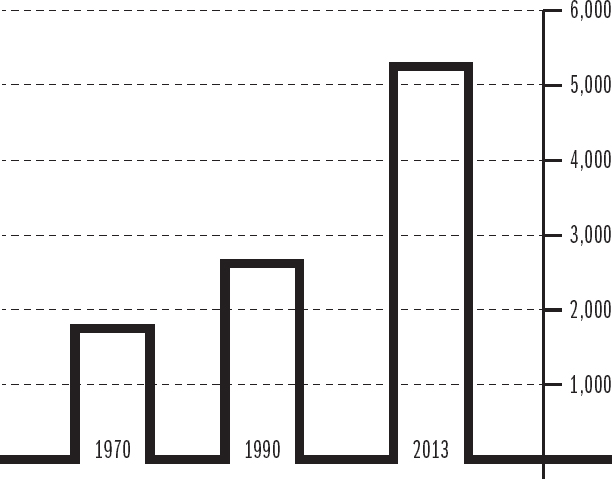
Figure 3.3 Average marketing messages per day (U.S. consumer).5
As a quick exercise, multiply the total numbers of messages per day by 365 days and then consider the amount of actual information customers receive—is it even possible to know what to trust with all that information? Customers having the means and opting to source information from people they trust starts to make a great deal of sense.
As a result, marketing has taken over the sales function because of the way purchasing behavior has changed. Only marketing can connect with the customer in the early stages of the purchase journey, stay engaged until the final purchase decision, and then beyond to cultivate loyalty. Not to diminish the importance of your sales department, but if the customer is the queen bee, marketing is its drone.
THE RISE OF THE MILLENNIAL
Because of their digital savvy and culture, Millennials, our digital natives, are leading the customer transformation. Now between the ages of 18 and 34, they're going to be your customers for a long time. So, understanding what makes them tick and how your business matches their needs is incredibly important, because if you're not getting the job done now, in 10 years, when the Millennials start reaching middle age, you're probably not going to be around.
MILLENNIALS AREN’T ALONE
Make no mistake; as early adopters, Millennials are leading the profound changes in the way business is conducted. They have channeled digital technologies into valuable tools for making purchase decisions. But they're not alone—they have company in the form of a broader group called Generation C, where C stands for “connected.” Gen C draws members from all age groups, and they are united by their decision to make all things digital an important part of their lifestyle.
According to Forrester Research, Gen C composition is predominantly made up of Millennials, but the Gen C mind-set is spreading as digital technologies make inroads into late adopters. Even with baby boomers, chances are that computers and the Web have been part of their workspaces and lives for years. Technology is not an unfamiliar part of their lives; it's just that baby boomers, and Gen X for that matter, didn't have access to all the cool stuff that's out there now. As they continue to see how technology makes life easier, more interesting, and perhaps even more valuable, it won't be long before even late adopters get on board.
BEHAVIOR ACROSS ALL AGES IS BEING TRANSFORMED
These behavioral shifts are occurring because getting connected, both physically and financially, has never been easier. Innovative digital technologies, combined with big bandwidth availability, has opened the connectivity floodgates to anyone who wants in. North American smartphone sales have now surpassed 140 million customers and are gaining strong penetration into the “late majority” of customers.6 At the same time, tablet sales have surpassed 50 million (while PCs have lost significant market share)! Marketers are now dealing with customers who use a variety of digital screens and are always connected. When you consider the iPhone was launched in 2007, and the iPad in 2010, this transition has happened incredibly fast, and remarkably high adoption levels of digital technologies have created fundamental changes in how business and marketing are conducted. To illustrate, here's a snapshot of U.S. market trends:7
- From 2008 to 2012, PC usage dropped from 78 percent to 57 percent as mobile devices took a prominent place in the lives of customers.
- Smartphones are now owned by 60 percent of households, and tablets have been purchased by 30 percent of households with Internet access.
- Phones and tablets now use up 44 percent of personal computing time, almost doubling since 2008.
- Communication modes have shifted from voice to data and video. E-mail and telephonic voice have fallen from 80 percent to 60 percent of our “communications” portfolio; cell phones are now used for talking 20 percent of the time, with more time used for streaming music, browsing websites, and playing games.
- Social media usage has doubled, using 25 percent of communications time.
- Almost 50 percent of video viewing is on-time or device-shifted to laptops, tablets, or mobile phones.
- Over 60 percent of music usage comes from streaming devices, MP3 files, or satellite radio, leaving AM/FM radio with just a 32 percent share.
- Even among customers aged 55–64, mobile phone usage exceeds that of landlines.
Overall, these are startling trends, especially when you consider most of these shifts have happened in the last five years. With digital access available anytime, anywhere, marketers face the incremental challenge of producing content that works seamlessly across all platforms and matches the needs of customers during the different stages of their purchase journey. Good content is gold, and if you're simply repurposing content without considering the unique usage inherent in each digital device, you're wasting time and money, and hurting your business. So, it's time to reframe your marketing model and start connecting with customers before they move to greener pastures.
THE RISE OF THE BRAND ADVOCATE
One of the most important outcomes of this digital transformation is the rise of a new and very powerful customer—the Advocate. Once known as Evangelists, these customers have dramatically increased their importance to your brand. With a globe gone digital and the power of social media, they have a platform to make their point of view known to everyone. Advocates have become incredibly valuable assets. Representing 16 to 20 percent of your customer base, they are brand believers and supporters, and in that role, influence the remaining 80 to 84 percent of your customers. Advocates are customers who write about your brand and share it with their personal, social, and business networks. You obviously need them on your side, because they have a disproportionate impact on persuading others to engage with and believe in your brand.
Getting the word out through customer endorsements is a prerequisite for brand success today. According to Everett Rogers's Diffusion of Innovation Adoption Curve, each category of adopters acts as an influencer and reference group for the next group. Rogers's theory was expanded by Chris Maloney to the “Maloney 16 Percent Rule.” He states that once you reach a 16 percent adoption rate for any innovation, it's time to change your messaging strategy from one based on scarcity to one based on social proof, in order to accelerate over the chasm and reach the masses. In this scenario, Advocates play a critical role in moving brands into new customer territories.
When I apply this thinking to a customer-centric context, it reminds me of how throwing a stone into a pond creates ripples that move outward in ever-increasing circles from the center to the pond's edge. Exchange the stone for an Advocate's positive post or recommendation, and you get an idea of how digital word of mouth works in today's connected world, and how Advocates’ messaging accelerates your brand across the chasm (see Figure 3.4).
These Advocates are your evangelists and sharecasters, and when given the right content, they will reshape it and spread it—it becomes a permanent repository of comments from your most valuable customers. Advocates are the early adopters of your product and will provide clear and concise feedback on the product. They will also be staunch defenders of your brand when it is attacked.
Because today's customers behave quite differently from those in the past, winning them and persuading them to become Advocates can be difficult. Customers have changed from being passive to being active and engaged, and Advocates exist on a level above that. It takes time and a disciplined series of interactions to build the right conditions for customer engagement, let alone advocacy, and it's never a conventional product message.
Increasingly, your organizational values and vision play an integral part in creating a relationship. Advocates, more than other customers, are examining and testing them regularly to make sure they continue to resonate with their own beliefs before they make a decision. That's the starting point, and the relationship will change and evolve as you move through awareness, engagement, and attachment to Advocate stages of the customer relationship process. Only when they have bought, tried, and had a positive experience with your offering will they consider becoming an Advocate for your brand (see Figure 3.5).
- Awareness: The starting point is always awareness. What do customers know about the brand and what the brand stands for? What are they saying to each other? Do they visit your website? How many page views? What is the visit duration? What do customer interest levels suggest?
- Engagement: Beyond awareness, are customers interacting with you, clicking through ads, signing up for experiential events, registering with contact information, following social media feeds, and so on?
- Attachment: Have customers strengthened their relationship and interacted with the brand by posting, blogging, and commenting/responding about the brand?
- Advocate: The last stage is when they become Brand Advocates and are actively recommending you to friends, sending links, posting on social media, or participating in the brand user community.
PRIMING THE ADVOCATE PUMP
Customers move through the awareness, engagement, attachment, and Advocate stages when they have bought, tried, and had positive experiences with your offering. To convert them into Advocates, you need to start a different kind of conversation. Mark Twain provided a good insight into what it's going to take:
“You can make more friends in two months by being interested in other people than in two years by making people interested in you.”
To start, you have to empathize with your prospective customers, understand their needs, and know how your product or service will make their lives better. From there, you need flaw-less product and service experiences, helpful and entertaining content, and access to insider knowledge. This combination encourages customers to turn into Advocates, and Advocates to persuade others in their social networks to join them: for example, “Here's a great video” or “Here's a special event you should check out.” Not only are you providing value to Advocates, but also you're developing content for them to pass along to their social universe.
BMW 1M CASE STUDY
To demonstrate how a customer-centric focus can engage and excite Advocates, here's a great example from the 2012 launch of the BMW 1 Series M Coupé. BMW had spent many years promoting the Joy of Driving, but with the launch of the BMW 1 Series M Coupé, there was an opportunity to communicate the brand's high-performance credentials. By engaging the brand's Advocates with great content in multiple, entertaining executions, Advocates were used to spread the message. Results were extremely powerful.
Our agency created a series of films that pushed the limits of performance, specifically with the intention of sparking discussion and creating dialogue around the BMW 1 Series M Coupé. The first film was entitled Walls and showcased the 1M's unbelievable precision-driving capabilities as it sped through a series of silhouette cutouts in concrete walls. The second film, Helipad, featured the 1M drifting atop the world highest helipad (Figure 3.6). Both pushed the limits, were thrilling and fun to watch, and delivered on high performance. To watch videos, go to BMW M-Powered Films: http://cundari.com/cases/bmw-m-powered-films.
We accessed out-of-home media, cinema, and rich online banners to drive traffic to YouTube. Our results were immediate; the conversation was ignited. Advocates took the discussion further, analyzing the films and posting their points of view on every film segment. Some even added their own soundtracks and created their own video games using the 1M manoeuvring through the walls (Figure 3.7).
Coverage from the marketing and automotive press was overwhelming, and it soon spilled over into mainstream media. After just two days, Walls was the most viewed, top-favorite, and commented on automotive video on YouTube, and within a month, the films had reached over 6 million combined views. To further fuel the discussion, we leaked behind-the-scenes footage.
The results were staggering: to date over 6.9 million online views, 575,800-plus YouTube comments, Facebook shares, tweets, blog posts, and news mentions. Best of all, following the launch of the campaign were three successive months of record-breaking sales in the history of BMW Canada (up 17 percent from the same month the year before).
The program's success received international recognition and was judged the top-ranked program in the WARC 100, The World's Smartest Campaigns. WARC compiled and analyzed the top global ad effectiveness and strategy competitions, and used those results to rank programs from around the world.
Achieving these results once can be considered an anomaly, but repeating and improving these results each year for consecutive new product launches indicates that there is more at work here than just a great campaign.
As a way of demonstrating this, with each new release, in 2011 (1M Walls and Helipad), 2012 (M5 Bullet High Performance Art), and 2014 (M4 Ultimate Racetrack), the time needed to reach the 3-million-view benchmark has shortened. While the 1M videos took a combined 25 days, the M5 and M4 videos needed only 9 and 5 days, respectively (see Figure 3.8).
When marketers say Advocates are worth more than their weight in gold, they're right! That means we're obligated to constantly provide exceptional value in content that exceeds Advocates’ expectations to keep them truly engaged and supporting our brands.

